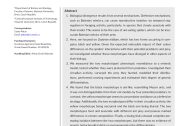Obsah
- Biological divergence results from several mechanisms. Defensive mechanisms, such as Batesian mimicry, can cause reproductive isolation via temporal seg- regation in foraging activity, particularly, in species that closely associate with their model. This seems to be the case of ant-eating spiders, which can be inaccurate Batesian mimics of their prey.
- Here, we focused on Zodarion nitidum, which has two forms occurring in sympatry, black and yellow. Given the expected noticeable impact of their colour differences on the spiders' interactions with their potential predators and prey, we investigated whether these morphotypes have diverged in other aspects of their biology.
- We measured the two morphotypes' phenotypic resemblance to a mimetic model, tested whether they were protected from predators, investigated their circadian activity, surveyed the prey they hunted, modelled their distributions, performed crossing experiments and estimated their degree of genetic differentiation.
- We found that the black morphotype is ant-like, resembling Messor ants, and it was not distinguishable from their ant models by four potential predators. In contrast, the yellow morphotype seems to use predator avoidance as a defensive strategy. Additionally, the two morphotypes differ in their circadian activity, the yellow morphotype being nocturnal and the black one being diurnal. The two morphotypes hunt and associate with different ant prey and possess marked differences in venom composition. Finally, crossing trials showed complete pre-mating isolation between the two morphotypes, but there was no evidence of genetic (mitochondrial data) or environmental niche differentiation.
- We conclude that the two morphotypes show evidence of a deep differentiation in morphological, behavioural, physiological and ecological traits that evolved together as part of the spider's diverging lifestyles.



